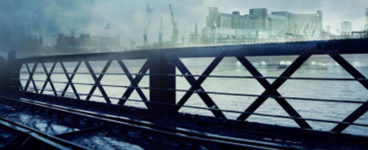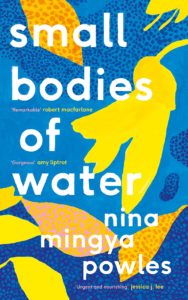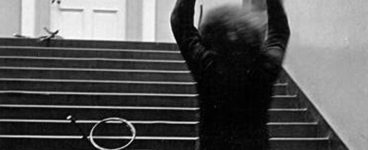‘I grew up with access to swimming lessons and public swimming pools – privileges that are easy to take for granted when you’re a child.’
Nina Mingya Powles first learned to swim in Borneo, where her mother was born and her grandfather studied freshwater fish. There, the local swimming pool became her first body of water. Through her life there have been others that have meant different things, but have still been, in their own way, home: from the wild coastline of New Zealand to a pond in the northwest of London.
Nina’s debut essay collection Small Bodies of Water, which weaves together personal memories, dreams and nature writing, and what it means to belong, won the inaugural Nan Shepherd Prize for nature writing. You can read a brilliant excerpt below.
Extract taken from Small Bodies of Water
By Nina Mingya Powles
Published by Canongate Books
‘I think about loving swimming the way you love somebody. How a kiss happens, gravitational.’
Leanne Shapton, Swimming Studies
5, Niagara Falls, Ontario
The orca glides from one end of the deep pool to the other. Upbeat music plays on the loudspeakers. A ponytailed woman wearing a full-body wetsuit stands on a platform, a white bucket placed by her feet. The music swells; the crowd leans forward on their seats. I imagine what it would be like to be in that pool, too, swimming swiftly alongside the whales under the stadium lights, perfectly at home in the aquamarine water. My mother raises her camera.
6, New York City
Half dream, half memory. The bottom and all four sides of the small pool are covered in silvery white tiles. Standing in the shallow end I can feel their ridged edges with my feet. I have my purple plastic goggles with iridescent gold lenses – when I put them on everything is like an underwater sunset. Outside the wide window, a city skyline glistens with heat. After swimming, I eat dinosaur-shaped chicken nuggets and French fries served on a blue picnic plate.
7, Sabah Golf Club, Kota Kinabalu
After our swim, we dry off in the shade next to the pool with our ice creams. Our favourite is the Häagen-Dazs one with chocolate ice cream coated in a milk chocolate shell. Wasps flit around my hair, attracted by the sugar, and Dad swats them away. From up here, we can see dark clouds passing swiftly from above the rainforest towards the town, and I can feel the afternoon heat becoming thicker, sweeter. Mum motions for me to move closer to her under the pool umbrella, getting ready for the downpour.
8, Thorndon, Wellington
Pink nylon, ice-white tiles. An unheated school pool is a lesson in how to breathe. Oak leaves and cracked acorns swirl on the surface of the water as we grope frantically for each other. Chipped fingernails, scraped knees. One, two! Breathe, kick! Mrs Ongley’s fists are in the air. Anna’s nosebleed brings the swimming lesson to a sudden end. Girls gasp and sneer at the little trail of blood droplets on the concrete.
9, Lower Hutt, Wellington
A hazy memory: an indoor swimming pool with high ceilings and a pink water slide spiralling down into the deep end. Every half hour, mechanised waves gently roll the water from one end to another, making our hips sway.
10, Thorndon, Wellington
I dream again of a heated pool filled with deep layers of memory. We huddle by the ladder in our regulation white swim caps and navy swimsuits, a dusting of talcum powder on our collarbones, our arms crossed tightly over our chests. My suit is coming undone at the left shoulder strap even though my mother’s sewn it up twice. I grip it self-consciously, worried the last threads will snap. The navy nylon is too small for me now, digging in at the hips. I can’t stand having my body out of the water, exposed to the wind, to other girls’ stares.
14, Xuhui District, Shanghai
My first two-piece, at fourteen: a black halter top tied behind the neck, with white, blue and pink polka dots, the Roxy logo embroidered on the matching briefs. I take my iPod, a bottle of water, a towel and a pack of Oreos down to the pool next to the car park. All summer, the cool, chlorinated water is a blessing. I float on my back under the corrugated plastic roof, which collapsed last winter under the weight of sudden snow. The lifeguard plays games on his phone while I do my slow strokes, alone. The heat can’t touch me: a girl swimming is a body of water.
16, Jinqiao, Shanghai
It’s too hot to be outside without some part of your body touching the water. The pool at the compound where my friend Jessie lives is in the shape of a heart, with dark blue tiles on the bottom and creamy white edges. We sit on the side of the pool, our toes dangling in the water, eating mini burritos wrapped in foil that Jessie’s mom made for us even though we said we weren’t hungry. I chew on the straw of a juice box. The white sun is behind the clouds but still the plastic lounge chairs feel hot to the touch. When boys from the year above us show up on the far side of the pool, we quickly rewrap our burritos and lower our bodies back into the deep end, gliding away.
19, Thorndon, Wellington
After my last exam I catch the bus down the hill. Thorndon pool glistens enticingly in the sunshine, the chemical colour of a blue popsicle. With my purple swimming cap and pink goggles on, I swim slow laps in the afternoon sun for thirty-five minutes. Getting dressed, my long hair feels coarse and a little bleached from the chlorine. It falls in waves around my sunburnt shoulders. My mum tells me to cut it but I won’t. I sit on the concrete steps above the pool to eat my bagel, in the exact same spot where I once stood huddled with a group of other twelve-year-old girls, shivering in the wind, trying in vain to cover up our exposed bodies which felt so awkward and new.
22, Karori, Wellington
Inside the aquatic centre it’s warm, humid, windowless. I pull on the swimsuit Mum bought me from a department store sale on our last family trip to Malaysia. It’s black with a sporty pattern of lilac stripes down the sides. I stuff my thick hair up into my purple swimming cap, sling my goggles around my neck and tiptoe across the yellow changing room floor. I’m terrible at exercising but I’ve started swimming regularly again in various public pools around the city: Thorndon summer pool, the site of many school swimming sports days of my childhood; Freyberg pool, perched on the edge of the sea; and here at Karori pool, all the way up in the bush-covered hills. When I lift my head above water I can hear the muffled sound of the wind beating against the roof.
I grew up with access to swimming lessons and public swimming pools – privileges that are easy to take for granted when you’re a child. The public pool is governed by rigid structures of gender, class, whiteness, the various shapes of our bodies. As Ellena Savage writes, ‘In the history of pool rules, there have been, and remain, rules of non-admission, rules of active discrimination. Not to let Aboriginal people in. Not to let female people in. Not to let trans people in. Not to let people in who can’t afford to pay.’ Inside the doors of the aquatic centre, with its rigid rules that so closely resemble the anxiety-inducing rules of high school PE class, I feel the urge to cover myself up under the gaze of the tall, athletic swimmers with special racing swim caps. Yet I blend in here in this overwhelmingly white space, with my light skin, my brown hair and my ability to pay the entry fee. I breaststroke too steadily for the slow lane, but too slowly for the medium lane. Away from the changing rooms, in the pool itself – a public body of water – I am a stronger version of myself. Sunlight pours through the glass walls around the pool and reflects brightly off my chlorinated skin.
25, Peak District, Derbyshire
A forest pool surrounded by soft ferns and foxgloves bent over by the wind. A blue reservoir glistens through the pine trees on either side of the little pool. The water is cool, soft, the colour of jasmine tea, submerging my skin in flickering red and orange light. This magic place is called Slippery Stones, and it’s true, the rocks are slick with dark moss. My boyfriend and I are some of the oldest people here – groups of teenagers smoke and listen to Frank Ocean in the grassy meadow, wearily watching all newcomers who lay their towels down, like languid guardians of the pool. I wince as the teenagers cannonball one by one into the dark water, aiming for the middle of the pool, the deepest part where you can’t touch the bottom. None of them miss. This place feels both wild and safely enclosed, with slow waterfalls at opposite sides of the pool where the amber-coloured water flows out to a steady stream, which in turn becomes the River Derwent.
26, Lucca, Italy
There are wasps in the grass around the path leading up to the pool. A garden pond is covered with netting to stop small children falling in. Pond lilies are beginning to bloom on the surface, blush pink against so much green. I’ve got my yellow bikini on under my cotton dress, a gingham pattern on seersucker fabric. There are two ripe peaches in my tote bag. I had one for breakfast, too, along with a boiled egg and toast. In August the peaches here are the sweetest, with marigold flesh, tinged red at the core of the fruit. The juice drips down as I eat one after my swim, drying sticky on my thigh.
Small Bodies of Water by Nina Mingya Powles is published by Canongate Books, priced £14.99.
ALSO IN THIS ISSUE

 The Book According To… Val McDermid
The Book According To… Val McDermid
‘I also plan to tell a series of damn good stories with some dead bodies along the way!’














